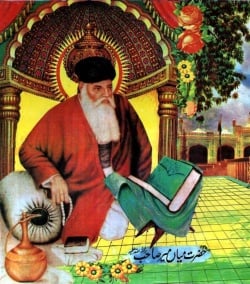Mian Mir and the Rose
Mir Mohammed Muayyinul Islam (1550-1635) was popularly known as Hazrat Mian Mir. He was a famous Muslim Sufi saint who resided in Lahore (in present-day Pakistan). He was a faqir of the Qadiri order of Sufism. A faqir is a word used to refer to a beggar or religious mendicant a man who has given up the search for worldly temptations and most often lives off of the donations that other men give him. In Sufi parlance a faqir, or dervish, is one who has attained the highest goal in earthly spirituality; a God-realized man.
Mian Mir spent most of his life in Lahore. A friend of The fourth and fifth Sikh Gurus Guru Arjun Dev Ji. He is widely believed to have laid the foundation stone of the Harmandir Sahib the Golden Temple on the 3rd of January 1588. He is known to have also attempted to intercede in the arrests of Guru Arjan and his father Guru Har Gobind.
The foundation-stone of the Harimandir Sahib
Guru Arjan was responsible for the construction of the holy tank called Amritsar or the pool of nectar in the city which now uses its name. In 1588, he planned a temple in the centre of the Sarovar. As the temple was to be open to people of all castes, creeds and religions, he invited Mian Mir to lay the foundation stone of the Harmandir Sahib. Mian Mir came to the city of Amritsar wearing a religious mendicant's long cloak made up of patches of coarse wool and a cone-shaped cap both of which were to make it obvious that he had given up wealth and expensive clothing, tattered rags were more than good enough for such a holy man.
His hat, often depicted as a large cone, was topped with a red rose. One may ask as I have in the past, why a red rose? I had been told that people just liked red roses or other flowers and there was no special significance to the Sant's use of that particular flower.
Further investigation reveals, as it often does in the East, that the use of a Rose, Tulip or Lotus has a deeper meaning or history. The Lotus (a flower widely admired for sitting so beautifully on the water's surface, though its roots are ancored in the mud below) is often seen as a motif in Hindu and Sikh temple architecture. One often reads the term "lotus feet of the Guru". Even Buddha is pictured seated on the flower.
The Qadria order of Sufism traces its origins to the Muhammad the Prophet through Hazrat Shaikh Abdul Qadir Jilani of Baghdad, its figurehead.
The Rose of Baghdad
Shaikh Sayyid 'Abd al-Qadir al-Jilani, (1077 - 1166) the founder of the Qadiri Order, gained the title the 'Rose of Baghdad' when he returned to teach in Baghdad which was, at the time, so full of mystical teachers that when he arrived at the city's gates the 'holy' men of the city decided to send him a message designed to keep him out. Often men who have achieved sucess and cornered a market seek to stop change--the only thing that the world guarantees. (Such was the resistance, to losing control of the easy and influential lives of wealth and comfort that the Mahants of Nanaka Sahib and Tarn Taran had grown to enjoy, that lead them to murder innocent Sikhs) The mystics therefore sent al-Jilani a vessel, full to the brim with water. The meaning was clear: ‘The cup of Baghdad is full to the limit--go away!’
Although it was winter and roses were out of season, Abdul Qadir produced a full-blown rose which he placed on top of the water, to indicate both his extraordinary powers and also that there was room for him in the crowded city. When this sign was brought to them, the assembly of mystics cried out: ‘Abdul Qadir is our Rose,’ and they hurried him into the city. (From The Way of the Sufi by Idries Shah)
Jilani's contributions to thought in the Muslim world earned him the title 'al-Gauth al Azam' (the "Supreme Helper"). The Qadria order is one of the oldest Sufi tariqas. It is the most widespread of the Sufi Orders in the Islamic world having spread to India, Bangladesh, Pakistan, Turkey, the Balkans as well as West Africa. Perhaps its most famous student was Dara Shikoh the son of Shah Jahan.
Even today red roses adorn the shrine or (dargah) of Hazrat Mian Mir Sahib, in Lahore. So when someone tells you 'A rose is just a rose' there may be something else at play.

